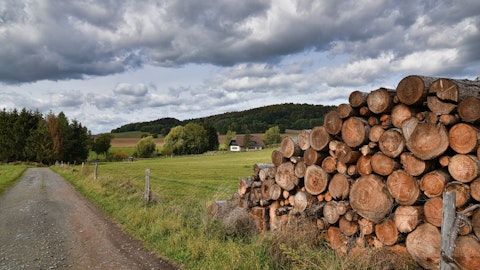Eric Cremers: Oh, yes, that was definitely material. And then, you raised a good point, which is our Southern prices weren’t really impacted by the Canfor announcement. It was really all about Idaho lumber prices, in particular. Yes, we saw a jump in the $30, $40, $50 a 1,000 kind of range, almost immediately from when that announcement was made.
Paul Quinn: And I suspect you’re anticipating further capacity closures in B.C. in ’23 here?
Eric Cremers: Yes. So, so far, we’ve seen, I don’t know, roughly 2 billion board feet of either permanent shutdowns or curtailments over the last 12 months. We continue to hear — we don’t operate up in B.C., as you know, but we continue to hear that B.C. is relatively high cost. And so, with these lower prices, I hear a lot of chatter about mills curtailing or closing. And yes, I think there’s an expectation that there could be more curtailments or closures, but that’s really up to those producers in that region.
Paul Quinn: Okay. And then just lastly, with the lower lumber pricing environment, has that freed up some of the timberland opportunities, i.e., is there more deals in the marketplace, or do you anticipate that in ’23?
Eric Cremers: Yes. The timberland M&A market right now, Paul, it’s pretty quiet. We’re coming off a really active 2022, so I guess it’s no surprise the market is going to have a little bit of a pause here. But with housing starts pulling back and with lumber prices pulling back, I’m guessing that sellers are choosing to wait until there are some signs of a recovery in housing starts and lumber demand to bring properties to market. Also, we suspect sellers might be holding back as carbon potential is becoming a bigger and bigger deal. But so far, it looks like it’s going to be a pretty quiet year on the timberland M&A front.
Paul Quinn: All right. That’s all I had. Thanks, guys. That’s all I had.
Eric Cremers: Thanks.
Jerry Richards: Thanks, Paul.
Operator: Our next question comes from Ketan Mamtora with BMO Capital Markets.
Unidentified Analyst: Hi, good morning. This is (ph) on behalf of Ketan at BMO. Just to start off with — back of Paul’s question here, can you talk a little bit about what you’re seeing in terms of lumber demand and channel inventory trends? Have you seen a change in the last recent weeks about the curtailment announcements?
Eric Cremers: Well, we’re not quite yet to the spring building season yet, so we haven’t really seen firm uptick in demand. I think what — dealers have been running with relatively low inventories all along and people are wondering how far prices are going to drop. So, they’ve been holding off from buying. I think we have seen a little bit of a pickup in demand here lately. People are starting to think, okay, prices have reached the bottom. They’re probably not going to go any lower. So, it’s time to step up buying. How that translates into end user demand, it’s really hard for me to say is we don’t really sell to direct users. I will say that on the R&R side, we sell to a number of home centers. And that side of our business has stayed remarkably strong.
We’re really happy with the R&R segment right now. And so, we’re feeling good about that segment. There’s no doubt housing starts are coming down this year relative to last year. That’s going to hurt overall lumber demand. But as we look out into 2024, we think the Fed is going to be cutting rates later this year, and we think starts will be back added again as we get out to 2024. We have started to see a few positive signs in housing. The homebuilder confidence has moved up off the lows. I’ve seen mortgage rates come down 100 basis points or so, and I’ve read articles about homebuilders buying down mortgage rates. Some — I think I read somewhere that one of the builders is offering a 5% mortgage rate to try to entice buyers. So, it’s not like it’s a complete disaster out there like it was after the great financial crisis.
But it’s — we’re not yet to the spring building season.
Unidentified Analyst: Thanks for that color. And then, can you tell us what’s the right way to think about decline in log prices in Idaho in Q1 is? How do you think about that?
Jerry Richards: Yes, it’s a great question. I mean, certainly, in Idaho and when you talk log costs, that’s certainly the logs that we’re buying ourselves to manufacture lumber and plywood. No question as lumber pricing has come down and we index the price of those logs, we’re going to see some early. That’s probably around the $3 million or so number for the first quarter, and then, additional relief, which could be significant, actually, as the year plays out.




